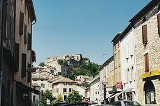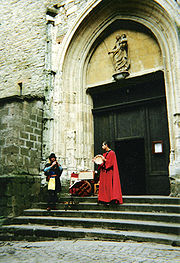
Cordes-sur-Ciel
Encyclopedia


Communes of France
The commune is the lowest level of administrative division in the French Republic. French communes are roughly equivalent to incorporated municipalities or villages in the United States or Gemeinden in Germany...
in the Tarn department
Départements of France
The departments of France are French administrative divisions. The 101 departments form one of the three levels of local government, together with the 22 metropolitan and 5 overseas regions above them and more than 36 000 communes beneath them...
in southern France
France
The French Republic , The French Republic , The French Republic , (commonly known as France , is a unitary semi-presidential republic in Western Europe with several overseas territories and islands located on other continents and in the Indian, Pacific, and Atlantic oceans. Metropolitan France...
.
The fortified town was built in 1222 by Raimon VII, the Count of Toulouse, who, though not a Cathar
Cathar
Catharism was a name given to a Christian religious sect with dualistic and gnostic elements that appeared in the Languedoc region of France and other parts of Europe in the 11th century and flourished in the 12th and 13th centuries...
himself, tolerated the heresy. The village is now a popular tourist spot. Until recently the town's name was Cordes, a word thought to come from the Indo-European
Proto-Indo-European language
The Proto-Indo-European language is the reconstructed common ancestor of the Indo-European languages, spoken by the Proto-Indo-Europeans...
root "corte" meaning "rocky heights."
History
In 1222, Cordes received its charter to become a "bastideBastides
Bastides are fortified new towns built in medieval Languedoc, Gascony and Aquitaine during the thirteenth and fourteenth centuries, although some authorities count Mont-de-Marsan and Montauban, which was founded in 1144, as the first bastides...
" from the Count of Toulouse. It is generally considered to be the first of the bastides of SW france. Bastides were "new towns" originally conceived to resettle and pacify people caught up in the Albigensian Crusade. Though not fortified, bastides were often built in defensible locations. It was built between 1222 and 1229 to protect the scattered population of the area from conflict. It was made to replace the village of Saint-Marcel
Saint-Marcel-Campes
Saint-Marcel-Campes is a commune in the Tarn department in southern France.-References:*...
, which was burnt down by the troops of Simon de Montfort
Simon de Montfort, 5th Earl of Leicester
Simon IV de Montfort, Seigneur de Montfort-l'Amaury, 5th Earl of Leicester , also known as Simon de Montfort the elder, was a French nobleman who took part in the Fourth Crusade and was a prominent leader of the Albigensian Crusade...
in 1215, during the Northern Baron's crusade against the Albigensians
Albigensian Crusade
The Albigensian Crusade or Cathar Crusade was a 20-year military campaign initiated by the Catholic Church to eliminate Catharism in Languedoc...
.
In the 1229 Treaty of Paris
Treaty of Paris (1229)
The Treaty of Paris was signed on April 12, 1229 between Raymond VII of Toulouse and Louis IX of France. Louis was still a minor and it was his mother Blanche of Castile who had been responsible for the treaty. The agreement officially ended the Albigensian Crusade in which Raymond conceded defeat...
Raymond VII of Toulouse
Raymond VII of Toulouse
Raymond VII of Saint-Gilles was Count of Toulouse, Duke of Narbonne and Marquis of Provence from 1222 until his death. He was the son of Raymond VI of Toulouse and Joan of England...
conceded defeat to Louis IX of France
Louis IX of France
Louis IX , commonly Saint Louis, was King of France from 1226 until his death. He was also styled Louis II, Count of Artois from 1226 to 1237. Born at Poissy, near Paris, he was an eighth-generation descendant of Hugh Capet, and thus a member of the House of Capet, and the son of Louis VIII and...
. In 1241, Jeanne, the Count of Toulouse, married Alphonse II
Alphonse of Toulouse
Alfonso or Alphonse was the Count of Poitou from 1225 and Count of Toulouse from 1247.-Life:...
the brother of Louis IX and the Count of Poitiers
Count of Poitiers
Among the people who have borne the title of Count of Poitiers are:*Guerin **Hatton **Renaud...
. As a result, Cordes became a part of France in 1271 without ever having been militarily conquered. In 1436 Rodrigo de Villandrando
Rodrigo de Villandrando
Rodrigo de Villandrando was a Spanish routier from Castile and mercenary military leader in Gascony during the final phase of the Hundred Years' War...
pillaged Cordes as part of the Hundred Years' War
Hundred Years' War
The Hundred Years' War was a series of separate wars waged from 1337 to 1453 by the House of Valois and the House of Plantagenet, also known as the House of Anjou, for the French throne, which had become vacant upon the extinction of the senior Capetian line of French kings...
.
The citizens of Cordes, having built their homes within the original 13th century ramparts, later escaped heavy damage during the religious wars at the end of the 16th century. As a result some excellent examples of 13th and 14th century gothic architecture
Gothic architecture
Gothic architecture is a style of architecture that flourished during the high and late medieval period. It evolved from Romanesque architecture and was succeeded by Renaissance architecture....
have been preserved.
Modern history
Cordes was revived in the mid-20th century, by artists and other visitors who noticed the town's beauty. Albert CamusAlbert Camus
Albert Camus was a French author, journalist, and key philosopher of the 20th century. In 1949, Camus founded the Group for International Liaisons within the Revolutionary Union Movement, which was opposed to some tendencies of the Surrealist movement of André Breton.Camus was awarded the 1957...
visited it in the 1950s and remarked that “In Cordes, everything is beautiful, even regret”.
In 1993 Cordes was renamed Cordes-sur-Ciel to reflect the town's site on a hill above the clouds that cover the valley below.
Points of interest
- The city is known for its medium sized outdoor market.
- Cordes is home to the Museum of the Art of Sugar and Chocolate. The museumMuseumA museum is an institution that cares for a collection of artifacts and other objects of scientific, artistic, cultural, or historical importance and makes them available for public viewing through exhibits that may be permanent or temporary. Most large museums are located in major cities...
contains hundreds of pieces of art made completely of sugarSugarSugar is a class of edible crystalline carbohydrates, mainly sucrose, lactose, and fructose, characterized by a sweet flavor.Sucrose in its refined form primarily comes from sugar cane and sugar beet...
. Subjects as diverse as the Middle AgesMiddle AgesThe Middle Ages is a periodization of European history from the 5th century to the 15th century. The Middle Ages follows the fall of the Western Roman Empire in 476 and precedes the Early Modern Era. It is the middle period of a three-period division of Western history: Classic, Medieval and Modern...
, mythologyMythologyThe term mythology can refer either to the study of myths, or to a body or collection of myths. As examples, comparative mythology is the study of connections between myths from different cultures, whereas Greek mythology is the body of myths from ancient Greece...
, technologyTechnologyTechnology is the making, usage, and knowledge of tools, machines, techniques, crafts, systems or methods of organization in order to solve a problem or perform a specific function. It can also refer to the collection of such tools, machinery, and procedures. The word technology comes ;...
and natureNatureNature, in the broadest sense, is equivalent to the natural world, physical world, or material world. "Nature" refers to the phenomena of the physical world, and also to life in general...
are illustrated in the museum's art. - The Jardin des ParadisJardin des ParadisThe Jardin des Paradis is a private garden located on the Place du Théron, Cordes-sur-Ciel, Tarn, Midi-Pyrénées, France. It has been recognized as a Jardin Remarquable since 2004, and is open daily in the warmer months; an admission fee is charged....
is a contemporary garden.
Geography
The village lies high above the left bank of the CérouCérou
The Cérou is an long river in the Aveyron and Tarn départements, southern France. Its source is at Saint-Jean-Delnous, northwest of the village. It flows generally west-northwest...
, which flows westward through the middle of the commune.

